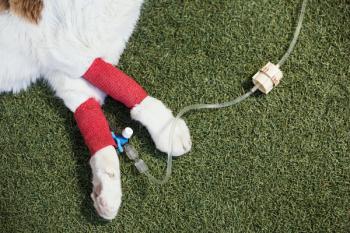
Storm Phobias: Study shows spike in canine cortisol levels
Drug therapy and behavior modification have been at least partially effective.
UNIVERSITY PARK, PA. — A study conducted by a Pennsylvania State University veterinarian is among the first to measure a stress hormone produced by a dog and its owner in response to stress in the home.
The most profound discovery in the research was that thunderstorm-anxious dogs experience a 207-percent spike in the production of cortisol, in addition to displaying classic signs of fear.
"The cortisol levels increased to a high degree in these dogs, regardless of how their owners responded to them," says Dr. Nancy Dreschel, Pennsylvania State University, lead researcher on the project.
The testing technique offers a new tool to assess animal welfare in a non-laboratory setting, including high stress environments like search and rescue and police-related pursuit.
"I am very interested in how physiological and behavioral stress responses interact and have known many dogs that suffer from thunderstorm phobia. I have always been struck with how troubling and frustrating a problem this is for the owners to deal with," Dreschel says. "I am interested in non-invasive ways of measuring stress and saw this research as a good opportunity to test these methods in the home situation."
To measure the cortisol response, in dogs and caregivers, researchers asked 19 dog-owner pairs to listen to a five-minute recording of a thunderstorm in their home while being videotaped.
The study included five purebred Golden Retrievers, one Corgi, a Keeshond, Border Collie, Labrador Retriever and 10 mixed-breed dogs weighing more than 15 pounds each.
Saliva samples were collected at three intervals prior to listening to the recording, 20 minutes after listening to the recording, and then 40 minutes after listening to the recording.
"On average, owners did not show an increase in cortisol, likely because they knew it was a recording," Dreschel, says.
Researchers found that dogs that live in multi-dog households had overall less change in cortisol compared to those in single-dog households. However the multi-dog household situations showed the animals had higher levels of cortisol before the tape was played.
"I think this research gives us more reason to take these issues seriously from the dog's health standpoint as well as the owner's peace of mind," Dreschel says. "While it can be frustrating to find the treatment that works the best for a given dog, pharmacological therapy, behavior modification and dog appeasing pheromone have all been shown to be at least partially effective for individuals."
The research paper was published in the December issue of Applied Animal Behaviour Science.
Newsletter
From exam room tips to practice management insights, get trusted veterinary news delivered straight to your inbox—subscribe to dvm360.





